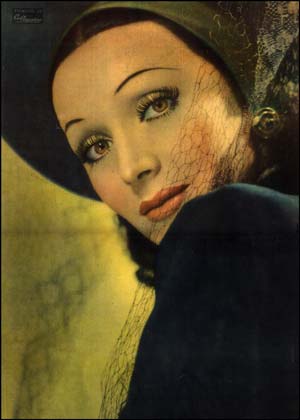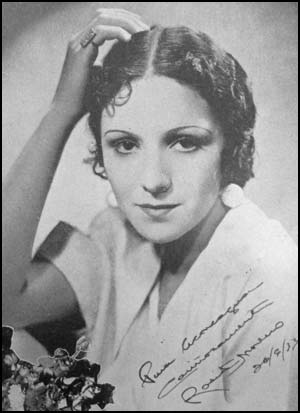By
Rosita Moreno, Gardel’s movie partner

he was daughter of a Spaniard, Francisco (Paco) Moreno (in fact, Juan Viñolas) who, by the end of the nineteenth century, moved to Mexico looking for a better fate. Then her father managed to run a hotel in the city of Pachuca. But then the revolution came and his finances became a chaos. Taking advantage of his Spanish origin and certain gifts for singing and dancing, besides the vogue for Spanish dances in the United States, he changed his name into Paco Moreno and traveled, firstly, to Broadway and later to Hollywood.
 It was not a bad experience. From 1930 and until his death in 1941 he appeared in around thirty movies. One of them was Sangre y arena (Blood and Sand) which starred Tyrone Power and Rita Hayworth. Later this man from Zaragoza teamed up with his wife Pilarica (in fact, Ascención Moreno) as duo and they even visited Buenos Aires when Rosita, who danced with them, was still a child.
It was not a bad experience. From 1930 and until his death in 1941 he appeared in around thirty movies. One of them was Sangre y arena (Blood and Sand) which starred Tyrone Power and Rita Hayworth. Later this man from Zaragoza teamed up with his wife Pilarica (in fact, Ascención Moreno) as duo and they even visited Buenos Aires when Rosita, who danced with them, was still a child.
Some years later, a little after her teen years, she was discovered by a Paramount producer while she was dancing at a venue in Paris. Nearby, in Joinville, the company had rented a movie studio to produce films spoken in Spanish. Sound movies were already known but subtitles and dubbing were unknown. Consequently, the North American movie industry was soon losing markets and there was where Rosita found her way.
In 1930 she was starred alongside one of the leading actors of that time, Adolphe Menjou (with whom she had auditioned satisfactorily in New York) in the movie Amor audaz, a story about international jewel robbers. The director was Louis Gasnier. After that she was the star in his motion pictures. Among them it is worthwhile to mention: No dejes la puerta abierta in which she shared the bill with Mona Maris, another of Carlos Gardel’s girls and, also, other two movies with the successful Mexican singer José Mojica who became famous when he became a priest.
 In the Rio de la Plata milieu, Rosita Moreno was exclusively recognized for her appearances alongside Gardel in Tango Bar and in El día que me quieras which was premiered in Buenos Aires the year after the accident in Medellín. In it, the outstanding scene is the one in which, in the role of Carlos’s wife, she dies and Gardel sits beside her and bitterly sings “Sus ojos se cerraron”. Later she reappears impersonating his daughter and nearing the end of the picture they, in a duet, sing some stanzas of, precisely, the theme song “El día que me quieras”. Rosita went on appearing in films for many years.
In the Rio de la Plata milieu, Rosita Moreno was exclusively recognized for her appearances alongside Gardel in Tango Bar and in El día que me quieras which was premiered in Buenos Aires the year after the accident in Medellín. In it, the outstanding scene is the one in which, in the role of Carlos’s wife, she dies and Gardel sits beside her and bitterly sings “Sus ojos se cerraron”. Later she reappears impersonating his daughter and nearing the end of the picture they, in a duet, sing some stanzas of, precisely, the theme song “El día que me quieras”. Rosita went on appearing in films for many years.
Besides her visit to Buenos Aires with her parents when she was a child she was also in our city several times: in 1936, in 1938, in 1940 and 1941. She appeared at the Teatro Maipo and was starred in two movies: El canillita y la dama, premiered on June 8, 1938 at the Monumental movie theater, also starring Luis Sandrini and directed by Luis César Amadori and La hora de las sorpresas, premiered on October 21, 1941 at the Broadway movie theater, starring Esteban Serrador, Pedro Quartucci and others and directed by Daniel Tinayre.
In her theatrical appearances, besides the numbers of her customary routine of singing and dancing, depending on the occasion she added songs of our folk music and a cueca that pleased the audience that showed her their enthusiasm. Her career was managed by her husband, a business man named Melville Shauer, who kept her working and traveling frequently and that shows that her career included more than the two movies with Gardel which made her well-remembered.
Director’s Note: In an interview published by the Clarín journal —a few years before Rosita’s death— and that was made at her last residence in Los Angeles, California, USA, she said that she appeared in around 80 movies and that she quit show business in 1954. As for Gardel she said:
 «Carlos was a very fine and delicate person, a pleasant and very simple man. I met him for the first time in an office of the Paramount. He came to say hello and since then I was quite comfortable with him. Watching him sing was marvelous. I was struck then by the fact that he performed several songs while seated, a feat that was difficult for some singers. In Tango bar we danced the excerpt of a tango. I had no problems, but in “El día que me quieras” when they told me that I had to sing one part with him, my legs trembled. He helped me a lot and he had a great facility to sing the second voice. There was a scene that caused much laughter. It was when we married and we abruptly fell just when we were about to enter our home. There were many jokes. He was very careful before the shots and the photographs and he was much concerned about his left profile because of a lack of hair that he tried to disguise with a hair-parting. Remembering Carlos and recalling the times spent with him is touching».
«Carlos was a very fine and delicate person, a pleasant and very simple man. I met him for the first time in an office of the Paramount. He came to say hello and since then I was quite comfortable with him. Watching him sing was marvelous. I was struck then by the fact that he performed several songs while seated, a feat that was difficult for some singers. In Tango bar we danced the excerpt of a tango. I had no problems, but in “El día que me quieras” when they told me that I had to sing one part with him, my legs trembled. He helped me a lot and he had a great facility to sing the second voice. There was a scene that caused much laughter. It was when we married and we abruptly fell just when we were about to enter our home. There were many jokes. He was very careful before the shots and the photographs and he was much concerned about his left profile because of a lack of hair that he tried to disguise with a hair-parting. Remembering Carlos and recalling the times spent with him is touching».
As for her career she added that she worked alongside Ray Milland and Cary Grant and that on some occasions she danced backed up by the Xavier Cugat orchestra.
Even though the portrayal written by Claudio España mentions other later entries to Argentina it does not say that Rosita returned to Buenos Aires for the first time in May 1933 and appeared with Pepe Arias in the Antonio Botta and Luis César Amadori’s revue La estrella de Los Angeles at the Teatro Maipo. Thereafter, before coming back to the United States, she traveled to Chile.
In certain notes published in journals and Internet sites the place of her birth appears mistakenly. It is mentioned Madrid (Spain) instead of Pachuca (Mexico) —which is the correct one according to the transcribed portrayal and it is also confirmed by our friend Pepe Crow who knew the star very well—. This confusion arose because her father filed her in the record as Spaniard when she was born. This was possible because in Spain –like in nearly all Europe- nationality is determined by jus sanguinis (right of blood) and not by place of birth. Finally, when based in the United States, in the city of Los Angeles, California, she became an American citizen.
Published in the La Nación newspaper on November 11, 1993 and released in the Tango y lunfardo magazine, Nº 92.